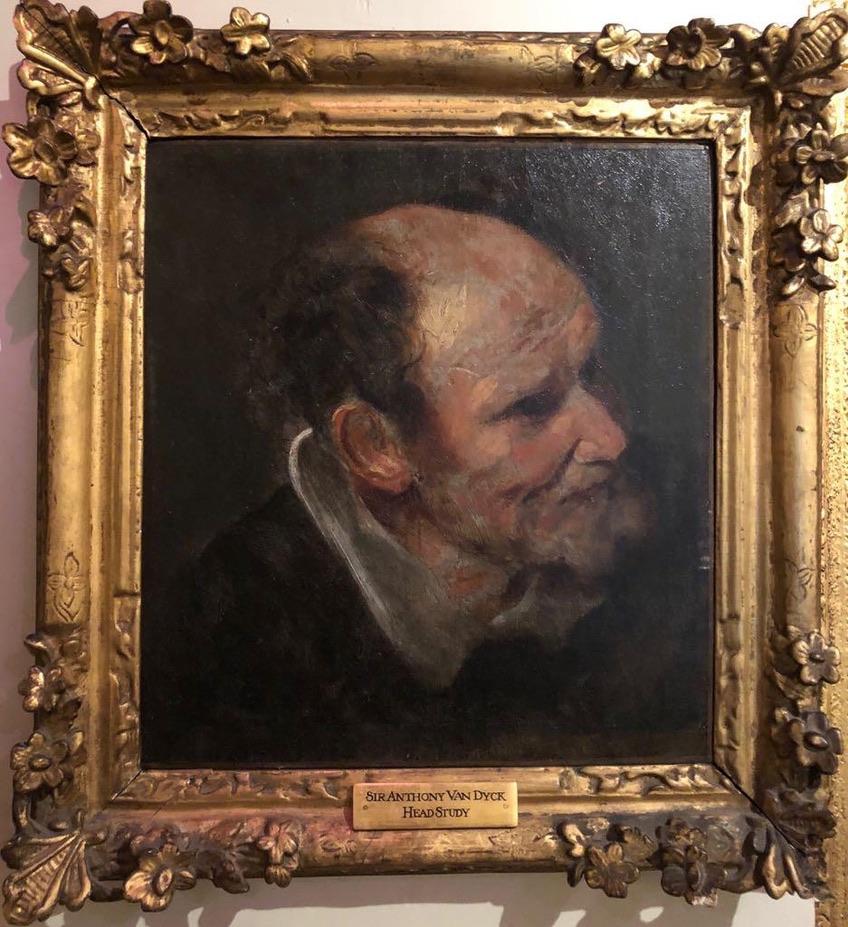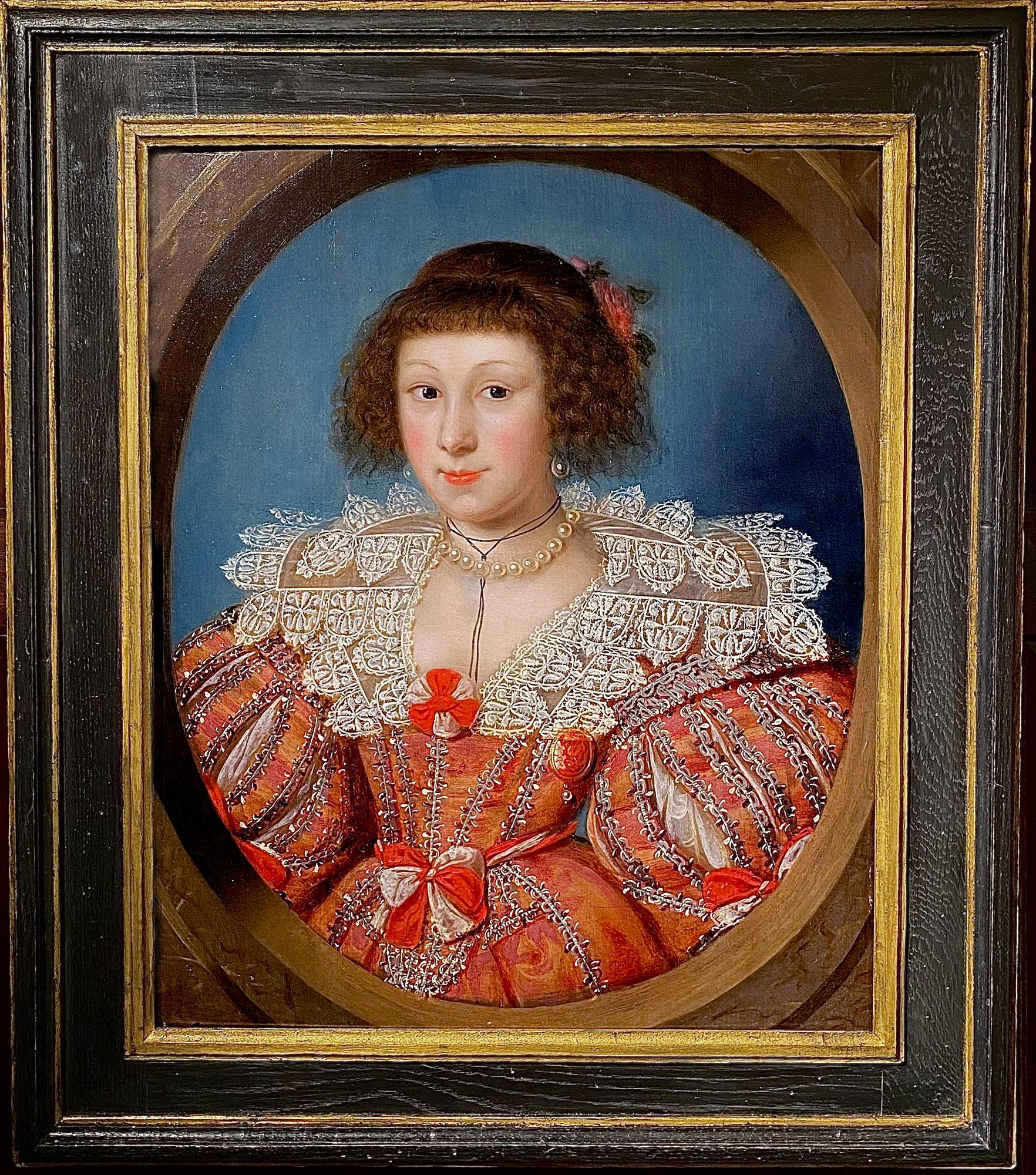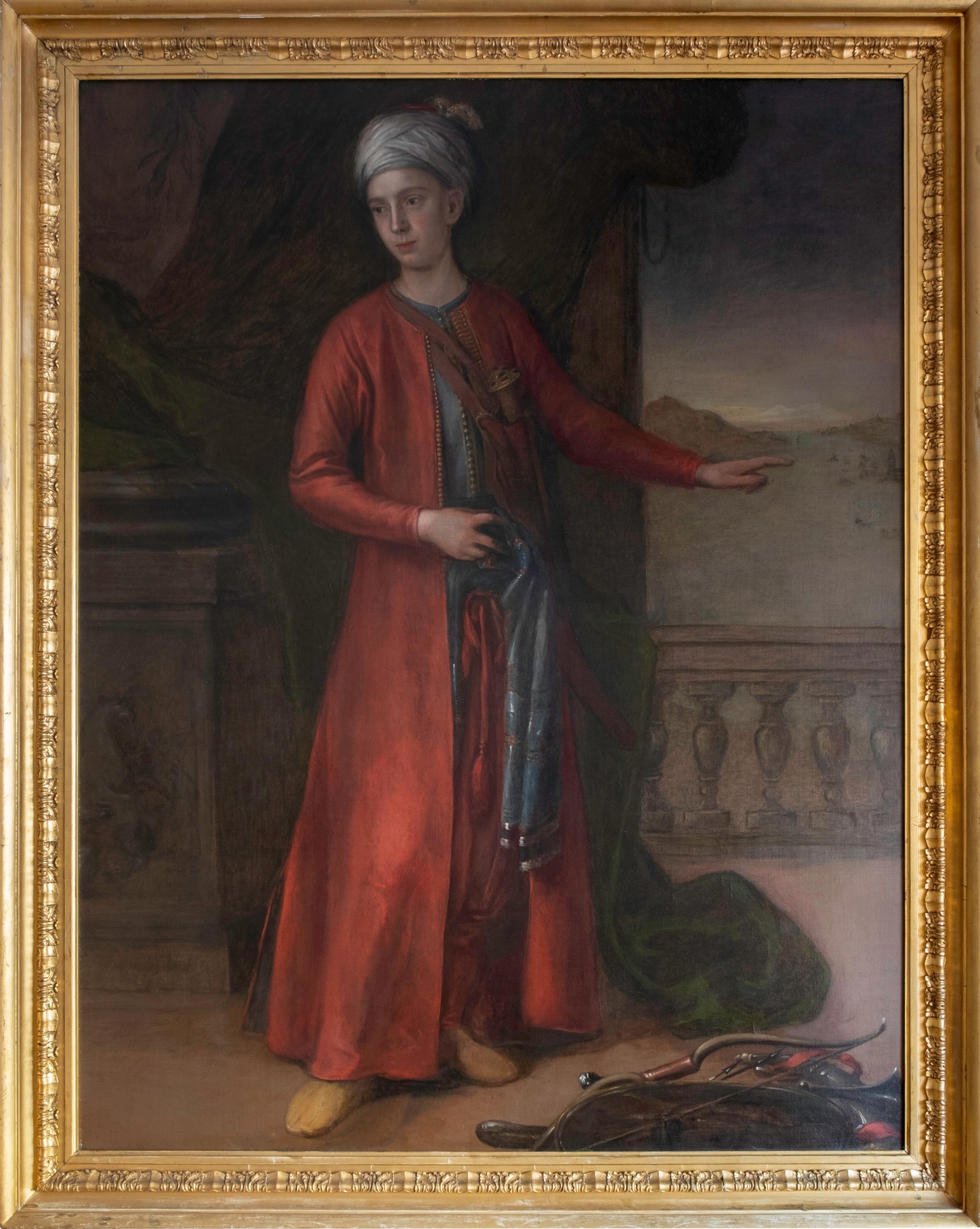Items Similar to Portrait of a Young Gentleman - Dutch Old Master 17thC art portrait oil painting
Want more images or videos?
Request additional images or videos from the seller
1 of 15
Portrait of a Young Gentleman - Dutch Old Master 17thC art portrait oil paintingCirca 1695
Circa 1695
About the Item
This superb Dutch Old Master portrait oil painting is attributed as by a follower of Dutch 17th century artist Gerrard van Honthorst. The original of this painting hangs in Wilton House, Wiltshire, home to the 18th Earl and Countess of Pembrokeshire. The painting was previously attributed to Van Dyck by early cataloguers, but after exhaustive comparisons with the two Honthorst brothers' works, it was concluded that Gerrard van Honthorst was the artist who painted the original in Wilton House. Our painting was painted circa 1695 by a follower of Gerrard Honthorst. It was sold to us as circle of Cornelius Johnson.
The sitter is Prince Rupert of the Rhine, Duke of Cumberland, Earl of Holderness (1619-1682). He was an English army officer, admiral, scientist, and colonial governor. He first came to prominence as a Royalist cavalry commander during the English Civil War. Rupert was the third son of the German Prince Frederick V of the Palatinate and Elizabeth, eldest daughter of King James VI and I of Scotland and England. His portrait was also painted by Peter Lely amongst others.
The painting is a bust length portrait of a Prince Rupert, wearing a grey slashed coat with a deep Van Dyck style lace collar and wide brimmed black felt hat, within a feigned oval. The detail on his lace collar is fantastic and his facial features are very sensitively portrayed, making this a rather special Dutch Old Master portrait.
Provenance. Sotheby's 28/5/93 lot 402.
Condition. Oil on canvas, 30 inches by 24 inches and in good condition.
Frame. Housed in a gallery frame, 37 inches by 31 inches and in good condition.
Gerard van Honthorst (Dutch: Gerrit van Honthorst; 4 November 1592 – 27 April 1656) was a Dutch Golden Age painter who became known for his depiction of artificially lit scenes, eventually receiving the nickname Gherardo delle Notti ("Gerard of the Nights"). Early in his career he visited Rome, where he had great success painting in a style influenced by Caravaggio. Following his return to the Netherlands he became a leading portrait painter.
Cornelius Johnson (1593-1661) was a portrait painter born in London of Dutch parents. He was also known as Johnson or Jonson van Ceulen (Cologne). Later variants of his name include Jansen or Janssens. He most likely trained in Holland, returning to London around 1618. He was one of the foremost portrait painters in England until Van Dyck arrived in 1632. After the start of the Civil War, Jonson retired to Holland, where he died. His son had the same name was also a portrait painter.
- Creation Year:Circa 1695
- Dimensions:Height: 37 in (93.98 cm)Width: 31 in (78.74 cm)Depth: 2 in (5.08 cm)
- Medium:
- Movement & Style:
- After:Gerrard van Honthorst (1592 - 1656, Dutch)
- Period:1650-1659
- Condition:
- Gallery Location:London, GB
- Reference Number:1stDibs: LU853113078272
About the Seller
5.0
Platinum Seller
These expertly vetted sellers are 1stDibs' most experienced sellers and are rated highest by our customers.
1stDibs seller since 2018
400 sales on 1stDibs
Typical response time: <1 hour
- ShippingRetrieving quote...Ships From: London, United Kingdom
- Return PolicyA return for this item may be initiated within 14 days of delivery.
More From This SellerView All
- Italian Greyhound and Friends - Italian 17thC Old Master dog art oil paintingBy Francesco FieravinoLocated in London, GBThis stunning Old Master 17th century oil portrait painting is attributed to Francesco Fieravino, an artist famous in his day for still lifes and carpets. This painting which dates t...Category
17th Century Old Masters Animal Paintings
MaterialsCanvas, Oil
- The Crucifixion - Flemish 18th century religious Old Master art oil paintingBy Anthony van DyckLocated in London, GBThis stunning Old Master oil painting is attributed to a follower of Anthony Van Dyck. Painted in the 18th century it is a superb large religious art work of the crucifixion of Chris...Category
1720s Old Masters Portrait Paintings
MaterialsOil
- Portrait of Lady in Mob Cap - British Old Master 18th century art oil paintingLocated in London, GBThis charming British Old Master Regency pastel portrait is attributed to John Russell RA. Painted circa 1790 the composition is a blonde woman in pretty mob cap with a blue ribbon. A really lovely image. Provenance. Oxford estate. Condition. Oil pastel on paper, 23 inches by 19 inches unframed and in good condition but has line in paper in middle. Frame. Housed in a fine frame, 30 inches by 26 inches framed and in good condition. John Russell RA (1745-1806) was an English painter renowned for his portrait work in oils and pastels, and as a writer and teacher of painting techniques. Russell was born in Guildford, Surrey, the son of John Russell Snr., book and print seller and five times mayor of the town; his father was something of an artist, and drew and published two views of Guildford. Russell was educated at the Royal Grammar School, Guildford, and soon showed a strong inclination for art. He trained under Francis Cotes RA (of Cavendish Square, London), one of the pioneers of English pastel painting, and, like Cotes, was an admirer of the pastel drawings of Rosalba Carriera whose methods influenced his technique of "sweetening". At the age of 19 he converted to Methodism, which was the cause of tension with his family and with his teacher; he made no secret of his strong evangelical leanings and would attempt to preach and convert at every opportunity. Russell set up his own studio, in London, in 1767. He made the acquaintance of the notorious Dr. William Dodd, whose portrait he painted in 1768. He was introduced to Selina, Countess of Huntingdon, who unsuccessfully attempted to persuade him to give up painting and attend her Methodist ministers' training college at Trevecca in Wales. On 5 February 1770, he married Hannah Faden, daughter of a Charing Cross print and map seller...Category
18th Century Old Masters Portrait Paintings
MaterialsOil
- Portrait of Boy Playing a Flute - 18th/19th century art Old Master oil paintingLocated in London, GBThis interesting painting is a British Old Master late 18th century or early 19th century oil painting attributed to Thomas Barker of Bath. It is stylistically very similar to his ot...Category
Early 1800s Old Masters Portrait Paintings
MaterialsOil
- The Annunciation to the Shepherds - Dutch 17thC art religious oil paintingLocated in London, GBThis wonderful 17th century Old Master religious oil painting is attributed to Dutch Golden Age artist Benjamin Gerritsz Cuyp. Painted circa 1633 it is entitled The Annunciation to t...Category
17th Century Old Masters Portrait Paintings
MaterialsOil
- Portrait of William Stonestreet - Dutch Golden Age 17thC art oil paintingLocated in London, GBThis superb Dutch Golden Age portrait is attributed to circle of Dutch artist Wybrand Simonsz de Geest. Painted in 1666 it is a full length portrait of a young William Stonestreet. H...Category
1660s Old Masters Portrait Paintings
MaterialsOil
You May Also Like
- Portrait of a Lady with a ChiqueadorLocated in New York, NYProvenance: Torres Family Collection, Asunción, Paraguay, ca. 1967-2017 While the genre of portraiture flourished in the New World, very few examples of early Spanish colonial portraits have survived to the present day. This remarkable painting is a rare example of female portraiture, depicting a member of the highest echelons of society in Cuzco during the last quarter of the 17th century. Its most distinctive feature is the false beauty mark (called a chiqueador) that the sitter wears on her left temple. Chiqueadores served both a cosmetic and medicinal function. In addition to beautifying their wearers, these silk or velvet pouches often contained medicinal herbs thought to cure headaches. This painting depicts an unidentified lady from the Creole elite in Cuzco. Her formal posture and black costume are both typical of the established conventions of period portraiture and in line with the severe fashion of the Spanish court under the reign of Charles II, which remained current until the 18th century. She is shown in three-quarter profile, her long braids tied with soft pink bows and decorated with quatrefoil flowers, likely made of silver. Her facial features are idealized and rendered with great subtly, particularly in the rosy cheeks. While this portrait lacks the conventional coat of arms or cartouche that identifies the sitter, her high status is made clear by the wealth of jewels and luxury materials present in the painting. She is placed in an interior, set off against the red velvet curtain tied in the middle with a knot on her right, and the table covered with gold-trimmed red velvet cloth at the left. The sitter wears a four-tier pearl necklace with a knot in the center with matching three-tiered pearl bracelets and a cross-shaped earing with three increasingly large pearls. She also has several gold and silver rings on both hands—one holds a pair of silver gloves with red lining and the other is posed on a golden metal box, possibly a jewelry box. The materials of her costume are also of the highest quality, particularly the white lace trim of her wide neckline and circular cuffs. The historical moment in which this painting was produced was particularly rich in commissions of this kind. Following his arrival in Cuzco from Spain in the early 1670’s, bishop Manuel de Mollinedo y Angulo actively promoted the emergence of a distinctive regional school of painting in the city. Additionally, with the increase of wealth and economic prosperity in the New World, portraits quickly became a way for the growing elite class to celebrate their place in society and to preserve their memory. Portraits like this one would have been prominently displayed in a family’s home, perhaps in a dynastic portrait gallery. We are grateful to Professor Luis Eduardo Wuffarden for his assistance cataloguing this painting on the basis of high-resolution images. He has written that “the sober palette of the canvas, the quality of the pigments, the degree of aging, and the craquelure pattern on the painting layer confirm it to be an authentic and representative work of the Cuzco school of painting...Category
17th Century Old Masters Paintings
MaterialsCanvas, Oil
- Portrait of Senator Bartolomeo Panciatichi by Santi di Tito (1574)Located in PARIS, FRThis recently rediscovered portrait of Santi di Tito depicts a Florentine senator, with a letter in his hand indicating that the painting was executed in 1574 when the sitter was 66 years old. On the basis of these clues, it is tempting to view it as a portrait of Bartolomeo Panciatichi, who was painted some thirty years before by Bronzino (1503 - 1572). While the treatment of the hands recalls the Florentine tradition of Mannerist portraits, the comparison with Bronzino's portrait illustrates Santi di Tito's search for greater realism, despite the stereotyped composition. 1. Santi di Tito, Counter-Reformation painter and portraitist Santi di Tito was the great painter of the Florentine Counter-Reformation. He proposed a new artistic language that broke away from Mannerism. Little is known about his training in Florence (perhaps alongside Bronzino or Baccio Bandinelli), but this period of training enabled him to join the Company of Saint Luke, the guild of Florentine painters, in 1554. Between 1560 and 1564, Santi di Tito spent time in Rome, where he frequented the workshop of Taddeo Zuccari. This stay had a fundamental influence on his work, thanks to the discovery of the late work of Raphael, but also his encounters with the painters Francesco Salviati and Federico Barocci. Around 1565, Santi di Tito returned to Florence, where he remained until the end of his life, dividing his talents between the creation of important religious paintings and countless portraits. He became one of the city's leading painters, distinguishing himself, in particular, in the creation of large religious compositions in which the spirit of the Counter-Reformation was reflected. In 1568, Santi di Tito became a member of the Confraternity of Saint Thomas Aquinas...Category
16th Century Old Masters Portrait Paintings
MaterialsPoplar, Oil
- Stunning 17th Century Oil Painting - Study of a Head of a ManBy Anthony van DyckLocated in London, GBStudio of Sir Anthony Van Dyck (1599-1641, Flemish) Study of a Head of Man Circa 1627-32, Van Dyck’s second Antwerp period Oil on paper, laid down on canvas Dimensions 15 x 14 inches...Category
17th Century Old Masters Portrait Paintings
MaterialsOil
- Portrait of a Girl, 17th Century English School Old Masters OilBy Gilbert JacksonLocated in London, GBGilbert Jackson English Active: 1620 - 1650 Portrait of a Girl Oil on panel, signed upper left and Inscribed upper right Image size: 24 ½ x 20 inches Contemporary style hand made...Category
17th Century Old Masters Portrait Paintings
MaterialsOil
- 18th C. Portrait of the 4th Earl of Sandwich a View of Constantinople BeyondLocated in London, GBJohn Montagu, 4th Earl of Sandwich (13 November 1718 – 30 April 1792) Attributed to George Knapton (1698-1778) Dressed in the Turkish manner, stand...Category
18th Century Old Masters Figurative Paintings
MaterialsOil
- Portrait of Gentleman, Thomas Bruce, Earl of Elgin c.1638 Manor House ProvenanceLocated in London, GBTitan Fine Art present this picture which formed part of a historic collection of an English aristocratic family, Lord and Lady Sandys at their magnificent baroque and Regency Grade-...Category
17th Century Old Masters Portrait Paintings
MaterialsOil, Wood Panel





